
Hygrophorus is a genus of agarics in the family Hygrophoraceae. Called "woodwaxes" in the UK or "waxy caps" in North America, basidiocarps are typically fleshy, often with slimy caps and lamellae that are broadly attached to decurrent. All species are ground-dwelling and ectomycorrhizal and are typically found in woodland. Around 100 species are recognized worldwide. Fruit bodies of several species are considered edible and are sometimes offered for sale in local markets.

Hygrocybe is a genus of agarics in the family Hygrophoraceae. Called waxcaps in English, basidiocarps are often brightly coloured and have dry to waxy caps, white spores, and smooth, ringless stems. In Europe they are characteristic of old, unimproved grasslands which are a declining habitat, making many Hygrocybe species of conservation concern. Four of these waxcap-grassland species, Hygrocybe citrinovirens, H. punicea, H. spadicea, and H. splendidissima, are assessed as globally "vulnerable" on the IUCN Red List of Threatened Species. Elsewhere waxcaps are more typically found in woodlands. Most are ground-dwelling and all are believed to be biotrophs. Around 150 species are recognized worldwide. Fruit bodies of several Hygrocybe species are considered edible and are sometimes offered for sale in local markets.
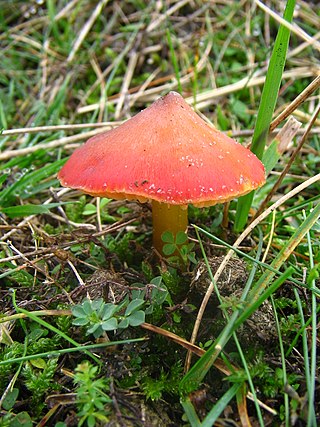
Hygrocybe conica is a species of agaric in the family Hygrophoraceae. In the UK it has been given the recommended English name of blackening waxcap, since all parts of the basidiocarp blacken with age. In North America it is commonly known as the witch's hat, conical wax cap or conical slimy cap. Hygrocybe conica is known to be a complex of at least eleven closely related species and as such is widespread in Europe, North America, Asia, and elsewhere.
Anthony "Tony" M. Young is an Australian mycologist based in Queensland, affiliated with the University of Queensland. He has published several books on fungi as well as a monograph on Australian Hygrophoraceae, resulting from his research on Hygrocybe and related genera. In 2007, he was a co-author of a review of the genus Ramaria in Australia, a work in progress which will see the likely description of 15 new Australian species and increase the total number to 50.

Porpolomopsis lewelliniae, commonly known as the mauve splitting wax-cap, is a gilled fungus of the waxcap family found in wet forests of eastern Australia and New Zealand. The small mauve- or lilac-coloured mushrooms are fairly common and appear in moss or leaf litter on the forest floor in autumn, and are biotrophic. The key distinguishing feature is the splitting of the cap dividing down the middle of the individual gills.
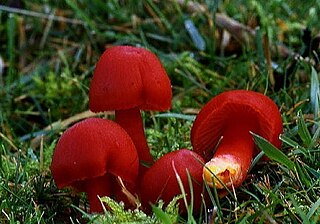
Hygrocybe coccinea, sometimes called the scarlet hood, scarlet waxcap or righteous red waxy cap, is a colourful member of the mushroom genusHygrocybe. These waxcaps are found across the Northern Hemisphere from China and Japan to Europe and North America. The small bright red mushroom is a familiar sight in unimproved grasslands in Europe in late summer and autumn, and woodlands in North America in winter.

Hygrocybe miniata, commonly known as the vermilion waxcap or miniature waxy cap, is a small, bright red or red-orange mushroom of the waxcap genus Hygrocybe. It is a cosmopolitan species, that is found worldwide. In Europe, it is found in fields, on sandy heaths, or grassy commons in the autumn. It is found in rainforest and eucalypt forest as well as heathland in Australia.

Gliophorus is a genus of agaric fungi in the family Hygrophoraceae. Gliophorus species belong to a group known as waxcaps in English, sometimes also waxy caps in North America or waxgills in New Zealand. In Europe, Gliophorus species are typical of waxcap grasslands, a declining habitat due to changing agricultural practices. As a result, two species, Gliophorus europerplexus and Gliophorus reginae, are of global conservation concern and are listed as "vulnerable" on the IUCN Red List of Threatened Species.
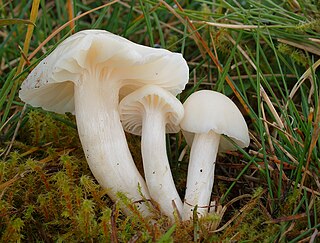
Cuphophyllus virgineus is a species of agaric in the family Hygrophoraceae. Its recommended English common name is snowy waxcap in the UK. The species has a largely north temperate distribution, occurring in grassland in Europe and in woodland in North America and northern Asia, but is also known from Australia. It typically produces basidiocarps in the autumn.

Cuphophyllus pratensis is a species of agaric in the family Hygrophoraceae. It has been given the recommended English name of meadow waxcap in the UK and in North America has variously been called the meadow waxy cap, salmon waxy cap, and butter meadowcap. The species has a widespread, mainly temperate distribution, occurring in grassland in Europe and in woodland elsewhere. The basidiocarps are edible and are occasionally collected and sold commercially.
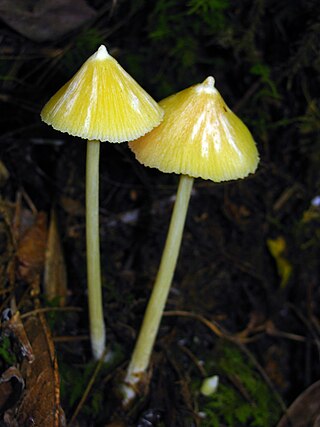
Entoloma murrayi, commonly known as the yellow unicorn Entoloma or the unicorn pinkgill, is a species of fungus in the Entolomataceae family. First described from New England (USA) in 1859, the species is found in eastern North America, Central and South America, and southeast Asia, where it grows on the ground in wet coniferous and deciduous forests. The fungus produces yellow mushrooms that have a characteristic sharp umbo on the top of a conical cap. The mushroom is inedible and may be poisonous. Other similar species can be distinguished from E. murrayi by differences in color, morphology, or microscopic characteristics.

Hygrocybe procera is a colourful Hygrocybe (waxcap) fungus. First described as Hygrophorus procerus by Greta Stevenson in 1963, the species was transferred to Hygrocybe in 1971 by Egon Horak. It is only known with certainty from New Zealand.
Hygrocybe kula is a mushroom of the waxcap genus Hygrocybe found only in Royal National Park and Lane Cove Bushland Park. It was described in 1997 by mycologist Cheryl Grgurinovic.

Hygrocybe cantharellus, commonly known as chanterelle waxy cap, is an agaric in the family Hygrophoraceae. It is found in eastern North America and Australia. The European Hygrocybe lepida was previously referred to this name, but is now known to be distinct.
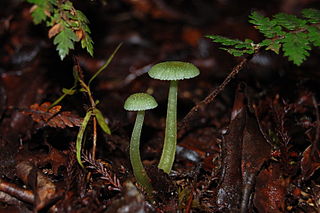
Gliophorus graminicolor is a species of agaric fungus in the family Hygrophoraceae. It is found in Australia and New Zealand. In 1995, Australian mycologists Tom May and Alec Wood transferred the species to Hygrocybe, but the taxonomic authority Index Fungorum retains it in Gliophorus.
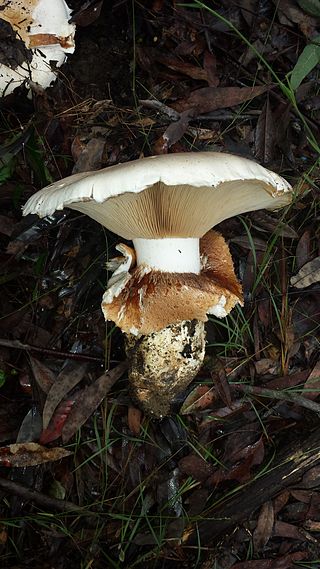
Austrocortinarius australiensis, commonly known as the skirt webcap, is a species of mushroom in the family Cortinariaceae which is native to Australia and New Zealand. The white mushrooms appear in autumn and can grow very large, with their caps reaching 30 cm (12 in) in diameter.
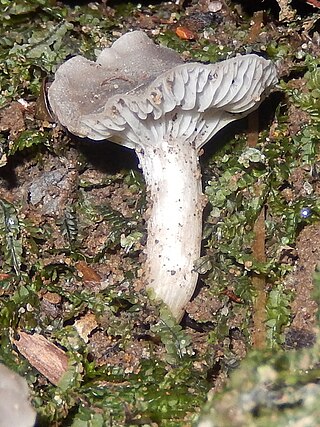
Hygrocybe griseoramosa is a mushroom of the waxcap genus Hygrocybe. It is grey or fawn in colour, and generally grows in moist, shady conditions. A rare species, it is only found near Sydney. Also this species has been found growing in Tasmania. It was described in 2001 by the mycologist Anthony M. Young.

Hygrocybe flavescens, commonly known as the golden waxy cap, is a species of Hygrocybe described from Michigan. It is considered nonpoisonous to humans. The species can be found in various forests and woodlands.

Hygrocybe erythrocala is a mushroom of the waxcap genus Hygrocybe. It grows in moist, shady conditions near Sydney, Australia. The cap is viscid and glossy with striations; this species lacks decurrent gills. It was described in 1997 by the mycologist Anthony M. Young.

















